Eight Famous Archangel Michael Paintings in Art
St. Michael the Archangel stands as a commanding figure in religious art, known for his strength, courage, and unwavering dedication to overcoming evil. For centuries, artists have endeavored to capture the essence of this celestial warrior in a myriad of ways, each of which brings a unique interpretation to his legendary story. In this article, I’d like to share some of the most famous Archangel Michael paintings and the fascinating stories behind them. If you have different opinions, feel free to discuss them in the comments!
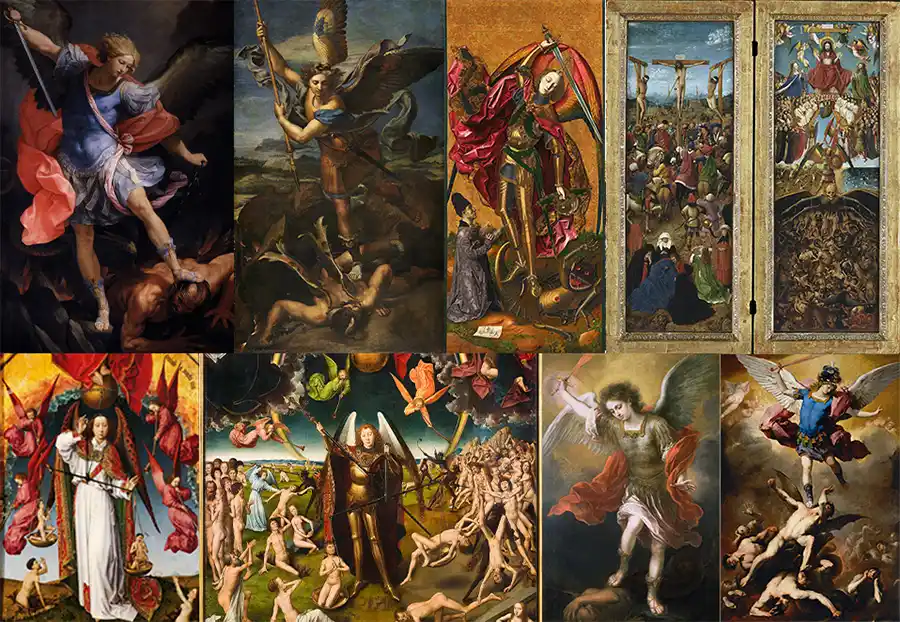
- What is the Most Famous St. Michael Painting?
- Other Famous Saint Michael paintings
- 1. Saint Michael Vanquishing Satan
- 2. The Fall of the Rebel Angels (Giordano)
- 3. The Last Judgment (Memling)
- 4. Crucifixion and Last Judgement diptych
- 5. Beaune Altarpiece
- 6. Archangel Michael plunges the devil into the abyss
- 7. St. Michael Triumphs Over the Devil
- The Origin of the Painting of the Angel Michael Slaying the Dragon
- The Origin of the Painting of the Angel Michael Holding Scales
- Conclusion
What is the Most Famous St. Michael Painting?
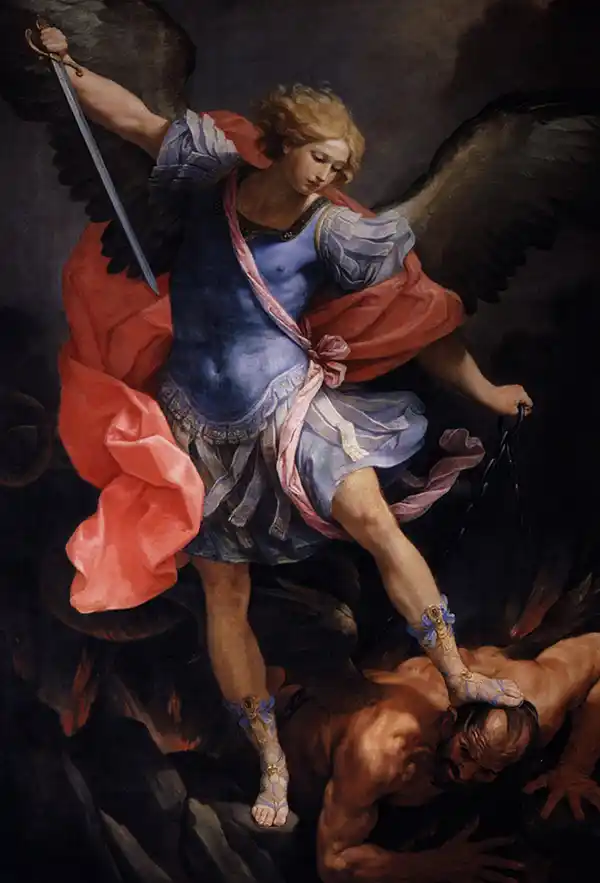
When discussing the iconic paintings of St. Michael, one cannot overlook Guido Reni’s “Archangel Michael defeats Satan,” housed in the Santa Maria della Concezione de Cappuccini, in Rome, painted in 1635.
In this art, Archangel Michael wears a late-Roman military cloak and cuirass. St. Michael holds the chains that bind Satan in his left hand. In his right hand, he holds a spear, poised to deliver justice. Every time I see this painting, I’m shocked by how much detail he put into Michael’s calves. The soft yet vivid color palette, combined with the dynamic composition, elevates this painting to one of the most celebrated depictions of Michael.
Reni’s work is known for its delicate balance between strength and grace. Michael’s calm expression contrasts with the panic of the demons below, emphasizing the triumph of good over evil. Light and shadow create a heavenly atmosphere around Michael, emphasizing his divine nature. This painting has become a significant source of inspiration in religious contexts and throughout the arts, symbolizing moral rectitude and divine justice.
Other Famous Saint Michael paintings
1. Saint Michael Vanquishing Satan
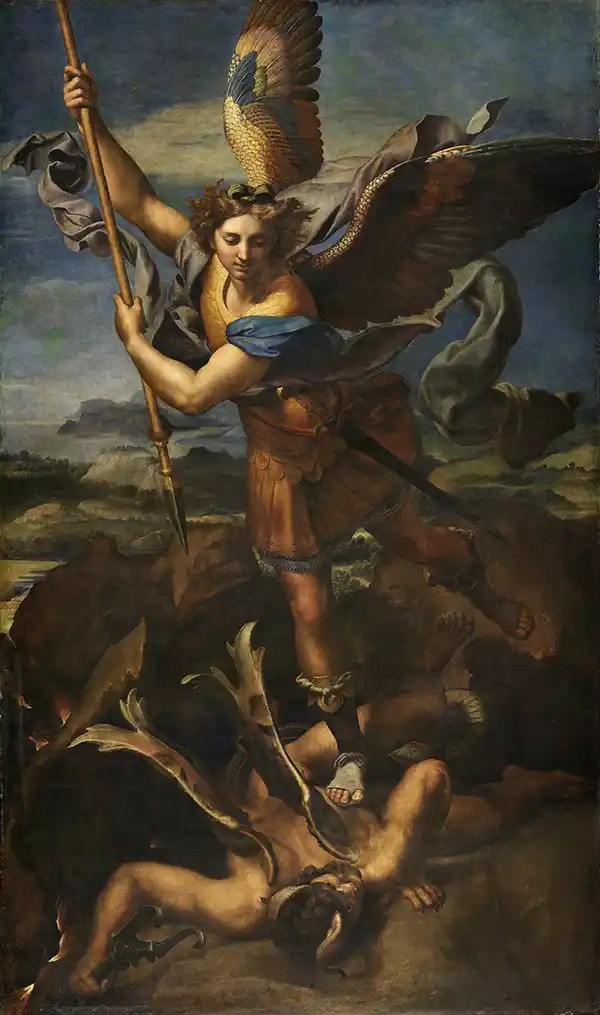
Beyond the works of Guido Reni, Raphael’s St. Michael’s Victory over Satan is also one of the most famous Michael art paintings. Completed in 1518, the painting was commissioned by Pope Leo X and has been in the Louvre in Paris since 1667.
In this painting, it’s clear that Raphael was inspired by Leonardo’s technique of creating movements that suspend time. The archangel’s body is depicted with his arms raised, one foot on Satan’s back, and the other foot in the air, as if time has been suspended, giving the impression of movement.
In addition, Raphael created a painting of St. Michael on the same subject in 1504 or 1505, known as “Little Saint Michael”.
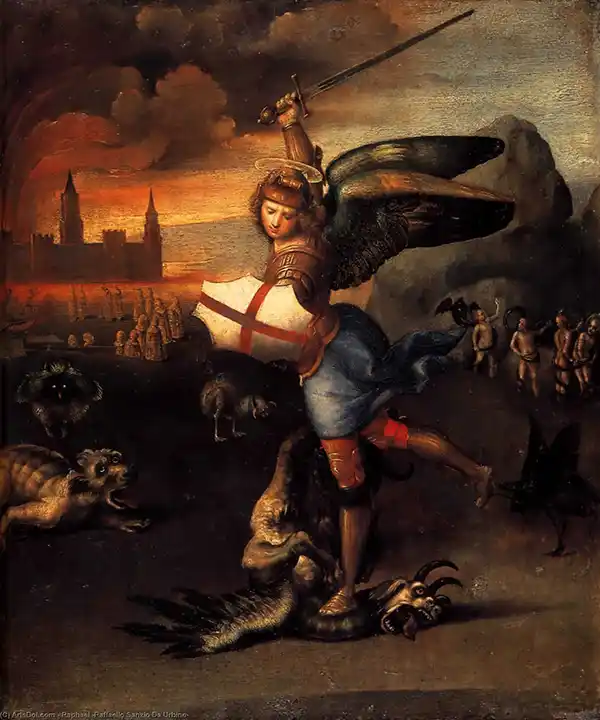
2. The Fall of the Rebel Angels (Giordano)
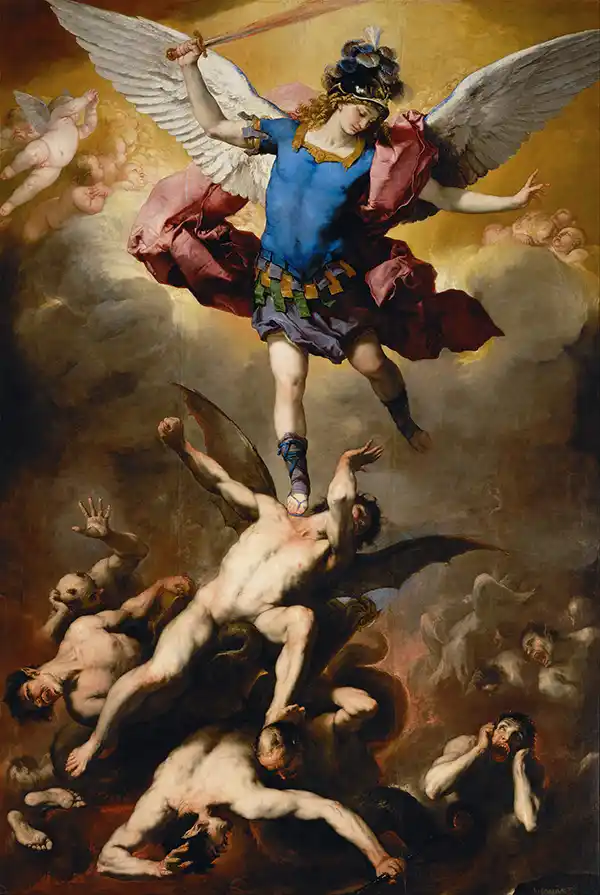
The Fall of the Rebel Angels is a painting by the Italian late Baroque artist Luca Giordano, from around 1666. It is now in the Kunsthistorisches Museum, Vienna. Its dimensions are 419 × 283 centimeters.
In this painting, St. Michael is depicted as a powerful and heroic figure, his gaze focused and determined in the face of the forces of evil. The churning clouds and vibrant colors create a sense of movement and drama, transporting the viewer to the battle in the sky. Giordano’s brushwork is dynamic, and his use of chiaroscuro intensifies the scene’s drama and brings it to life, making it a truly memorable work.
By the way, it is really astonishing how large that painting is. The difference between this painting and an earlier one on the same subject by Giordano a few years earlier (1663), which is now in the Gemäldegalerie in Berlin, is that in the Viennese one, the saint is holding a sword instead of a spear.
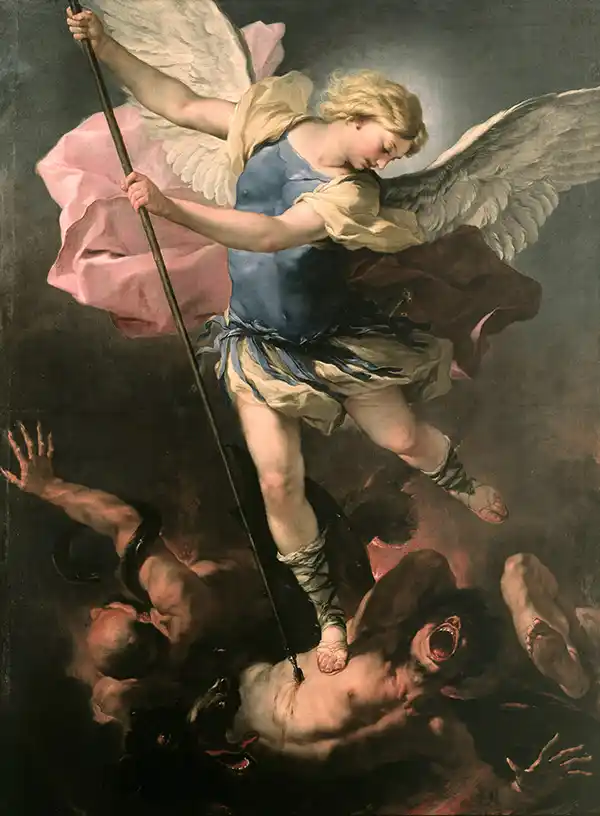
3. The Last Judgment (Memling)
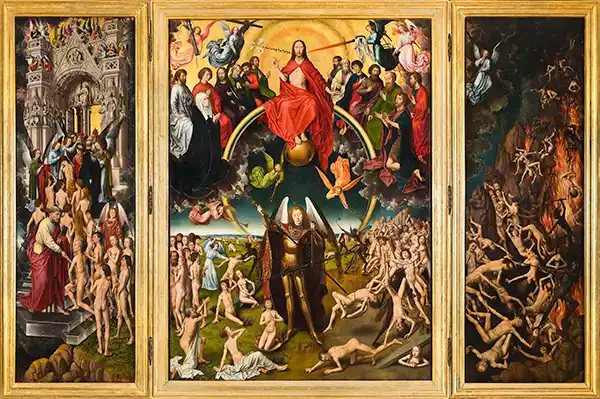
Hans Memling’s “The Last Judgment” is a triptych that offers a panoramic view of the final judgment.
St. Michael appears as a central figure, holding scales to weigh the souls of the dead. The painting, which was painted between 1467 and 1471, and is now housed in the National Museum in Gdańsk, Poland, is a masterpiece of Northern Renaissance art.
Unlike traditional depictions of St. Michael’s victory over Satan, this painting emphasizes the role of Michael as weighing peoples’ merits. Memling’s use of color and form creates a sense of solemnity and reverence, inviting viewers to reflect on the themes of judgment and salvation.
4. Crucifixion and Last Judgement diptych
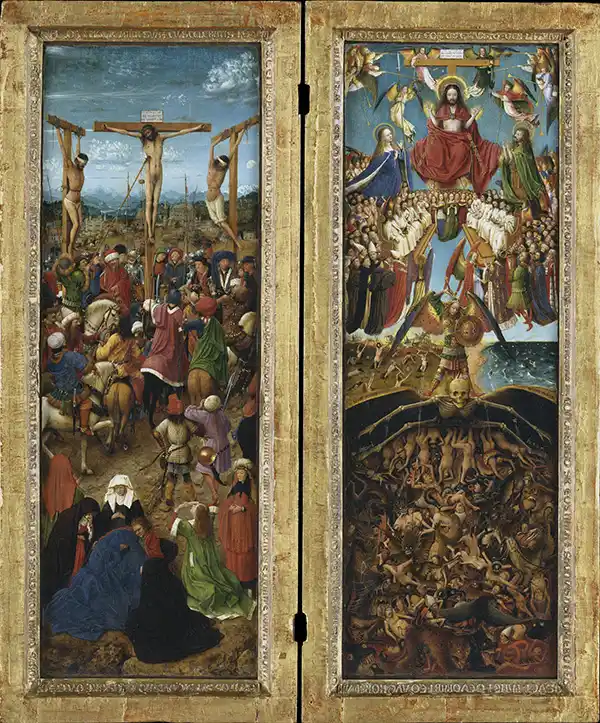
The painting is attributed to the artist Jan van Eyck and was created in 1430-40, and now in the Metropolitan Museum of Art, New York. It was made in miniature; the panel is only 56.5 centimeters (22.2 inches) high by 19.7 centimeters (7.8 inches) wide. It is known for its unusually complex and detailed imagery and the virtuosity with which it was executed.
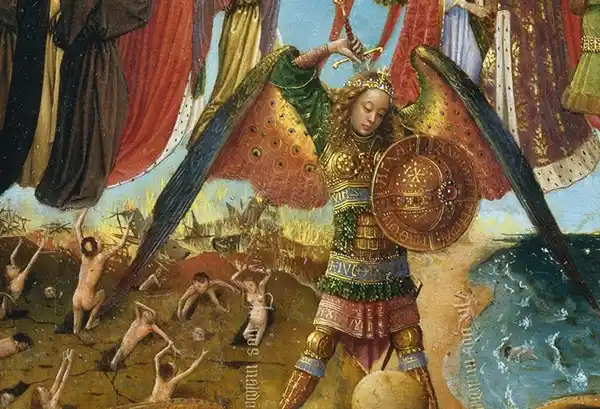
In the Last Judgment panel, St. Michael is depicted wearing simple armor and holding a sword. At his feet is a skeleton with outstretched limbs and wings. From its belly, sinful souls, including bishops, nobles, and a pregnant woman, are banished to Hell to undergo demonic torment.
5. Beaune Altarpiece
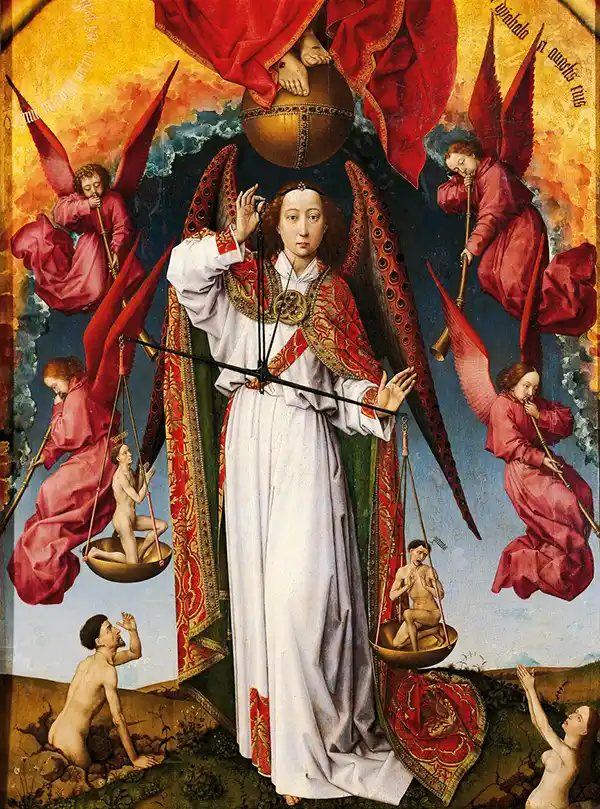
Rogier van der Weyden’s Beaune Altarpiece is a masterpiece that captures the drama of the Last Judgment. Created in 1443-1451, and now is in Hospices de Beaune.
St. Michael stands in the center of the picture as the heavenly Judge, the embodiment and representative of divine justice. With a cold face, holding a pair of scales to weigh souls, and wearing a red cloak with a shimmering white robe wrapped around a cloak of gold fabric, he is the most vibrantly colored figure in the lower panels, “hypnotically captivating the viewer’s gaze.” His feet are positioned as if he were stepping forward, about to step off the canvas, and he looks directly at the observer, giving the illusion that he is judging not only the soul of the painting but the viewer as well.
6. Archangel Michael plunges the devil into the abyss
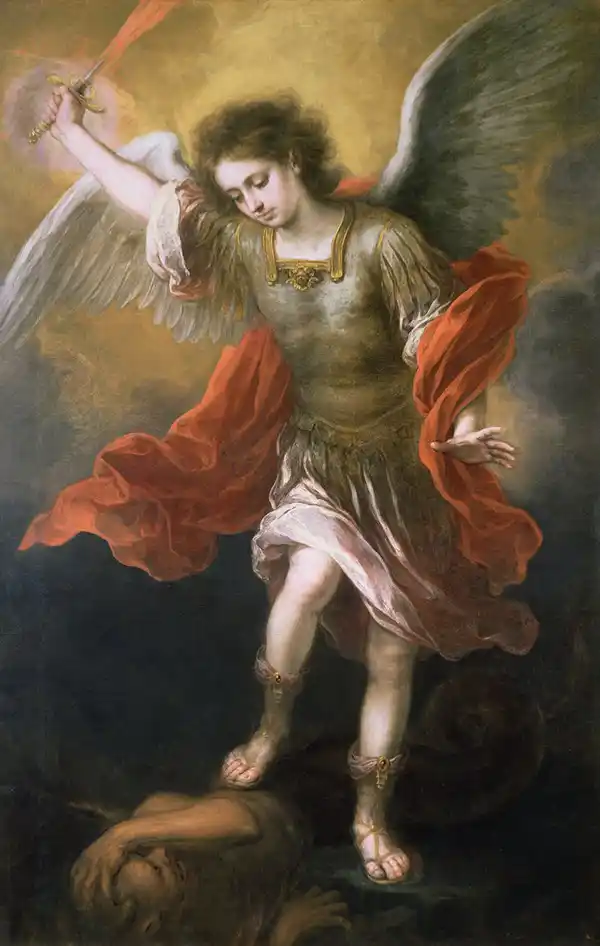
This painting was created by the Spanish artist Bartolomé Esteban Murillo around 1666-1668. And is currently in the Kunsthistorisches Museum in Vienna.
Murillo was one of the most admired and popular of all European artists in the 18th and early 19th centuries. His work is more widely known than that of any other Spanish artist before the 19th century.He is known for his soft, ethereal style, and portrays St. Michael with a serene yet powerful presence. The use of light and delicate brushwork gives the painting a dreamlike quality, emphasizing Michael’s divine nature.
7. St. Michael Triumphs Over the Devil
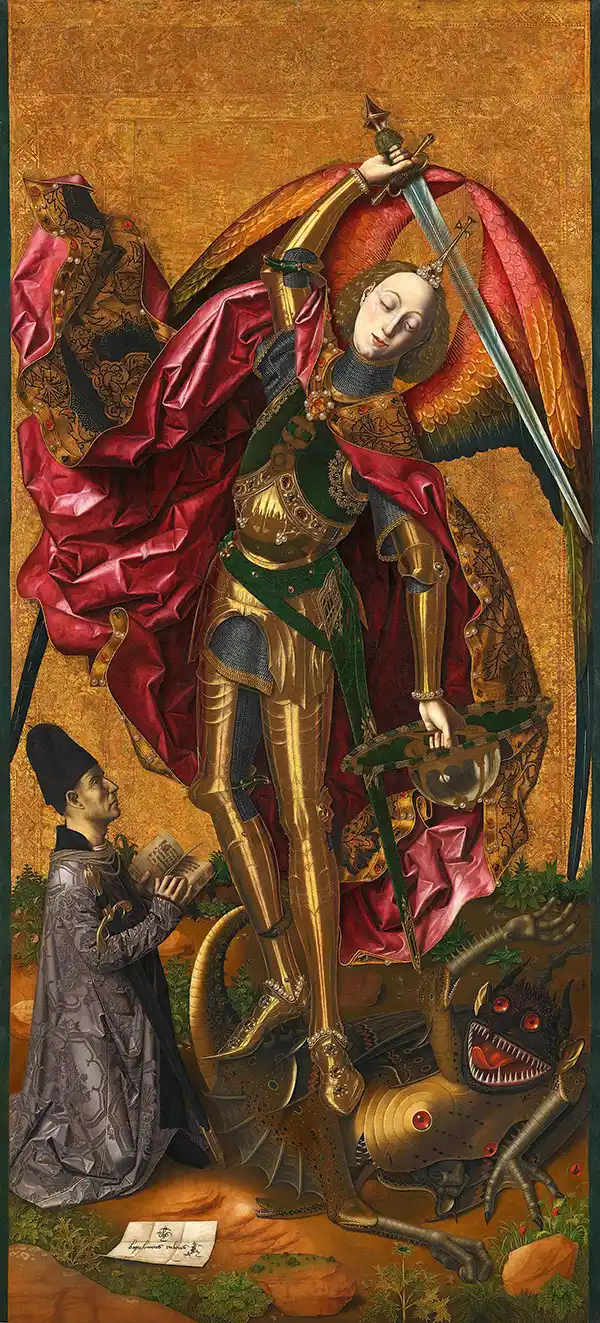
Among the many depictions of St. Michael, Bartolomé Bermejo’s “St. Michael Triumphs Over the Devil” holds a special place in my heart. Painted in 1468, and is now in the British Museum.
Bermejo’s St. Michael is a figure of regal authority, clad in ornate armor and crowned with a halo of divine light. The use of color and detail is exquisite, notice the buildings reflected in the breastplate. That’s obviously a real place. Michael’s adornment with pearls and rubies is also interesting, I’m guessing that pearls in this context have a heavenly or a pure association. The outside of Michael’s cape has a tree motif, which is most likely the Tree of Life.
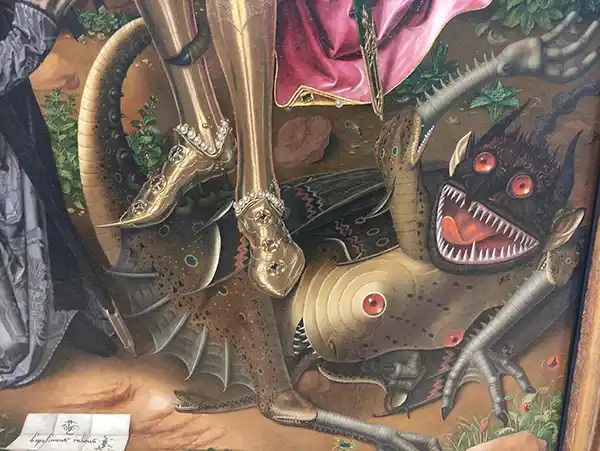
This work is a masterpiece of Spanish Gothic art.
The Origin of the Painting of the Angel Michael Slaying the Dragon
The imagery of Archangel Michael slaying the dragon is rooted in biblical narratives, specifically from the Book of Revelation 12:7-9, Michael and his angels battle and defeat the dragon, symbolizing the triumph of good over evil:
7 And war broke out in heaven: Michael and his angels fought with the dragon; and the dragon and his angels fought,
8 but they did not prevail, nor was a place found for them in heaven any longer.
9 So the great dragon was cast out, that serpent of old, called the Devil and Satan, who deceives the whole world; he was cast to the earth, and his angels were cast out with him.
The earliest depictions of this scene date back to the early Christian period, with mosaics and frescoes adorning the walls of churches and cathedrals. These early artworks set the stage for later interpretations, each artist adding their unique flair to the timeless story.
The Origin of the Painting of the Angel Michael Holding Scales
Another popular depiction of Archangel Michael is as the judge of souls, often illustrated holding scales. This imagery is derived from the Christian belief in the Last Judgment, where Michael is tasked with weighing the souls of the deceased.
In Roman Catholicism, St. Michael has four different roles. First, he was the protector. He defeated Satan, cast him out of heaven, and will be victorious in the final battle with Satan. Second, he is the Christian angel of death: at the hour of death, St. Michael descends to allow everyone to atone for their sins before they die. St. Michael’s third role is to weigh people’s merits on the Day of Judgment (hence the saint is often depicted holding the scales). Finally, St. Michael is the patron of the Church.
Conclusion
As we admire these works of art, we’re reminded of the timeless appeal of St. Michael’s story and the enduring power of art to convey profound spiritual truths. He a beacon of inspiration, guiding us through the complexities of life with strength and courage.
